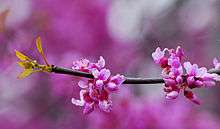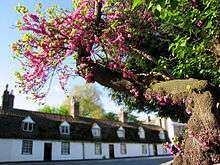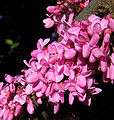Cercis
Cercis /ˈsɜːrsɪs/[5] is a genus of about 10 species in the subfamily Cercidoideae of the pea family Fabaceae,[3] native to warm temperate regions. It contains small deciduous trees or large shrubs commonly known as redbuds.[6] They are characterised by simple, rounded to heart-shaped leaves and pinkish-red flowers borne in the early spring on bare leafless shoots, on both branches and trunk ("cauliflory"). Cercis is derived from the Greek word κερκις (kerkis) meaning "weaver's shuttle", which was applied by Theophrastus to C. siliquastrum.[7]
| Cercis | |
|---|---|
 | |
| C. siliquastrum (Judas tree) | |
| Scientific classification | |
| Kingdom: | |
| (unranked): | |
| (unranked): | |
| (unranked): | |
| Order: | |
| Family: | |
| Subfamily: | |
| Tribe: | Cercideae[2] |
| Genus: | Cercis |
| Type species | |
| Cercis siliquastrum L. | |
| Species | |
|
10–24; see text. | |
| Synonyms[4] | |
| |
Cercis species are used as food plants by the larvae of some Lepidoptera species including Mouse Moth and Automeris io (both recorded on Eastern Redbud).The bark of C. chinensis has been used in Chinese medicine as an antiseptic.[8]
Species
Cercis comprises the following species:[3][6][10][11]
- Cercis canadensis L. – eastern redbud (eastern North America)
- Cercis chinensis Bunge—Chinese redbud (East Asia)
- Cercis chingii Chun—Ching's redbud (China)
- Cercis chuniana F.P.Metcalf (China)
- Cercis glabra Pamp.—Yunnan redbud (China)
- Cercis griffithii Boiss.—Afghan redbud (southern central Asia)
- Cercis hebecarpa (Bornm.) Ponert
- Cercis mexicana Rose – Mexican redbud (northeast Mexico and Texas (Trans-Pecos) )
- Cercis occidentalis Torr. ex A. Gray – western redbud (Western United States)
- Cercis racemosa Oliv.—chain-flowered redbud (western China)
- Cercis reniformis Engl. – Oklahoma redbud (Oklahoma and Texas (East of the Pecos River) )
- Cercis siliquastrum L.—Judas tree or European redbud (Mediterranean region)

The Judas tree (Cercis siliquastrum) is 10–15 m tall tree native to the south of Europe and southwest Asia. It is found in Iberia, southern France, Italy, Bulgaria, Greece and Asia Minor, and forms a low tree with a flat spreading head. In early spring it is covered with a profusion of magenta flowers which appear before the leaves. The flowers are edible and are sometimes eaten in a mixed salad or made into fritters with a flavor described as an agreeably acidic bite. The tree frequently figured in the 16th and 17th century herbals. It is said to be the tree from which Judas Iscariot hanged himself after betraying Christ, but the name may also derive from "Judea's tree", after the region encompassing Israel and Palestine where the tree is commonplace.
A smaller Eastern American woodland understory tree, the eastern redbud, Cercis canadensis, is common from southernmost Canada to Piedmont, Alabama and East Texas. It differs from C. siliquastrum in its pointed leaves and slightly smaller size (rarely over 12 m tall). The flowers are also used in salads and for making pickled relish, while the inner bark of twigs gives a mustard-yellow dye. It is commonly grown as an ornamental.[12]
The related western redbud, Cercis occidentalis, ranges from California east to Utah primarily in foothill regions. Its leaves are more rounded at the tip than the relatively heart-shaped leaves of the eastern redbud. The tree often forms multi-trunked colonies that are covered in bright pink flowers in early spring (February - March). White-flowered variants are in cultivation. It buds only once a year.
The chain-flowered redbud (Cercis racemosa) from western China is unusual in the genus in having its flowers in pendulous 10 cm (4 in) racemes, as in a Laburnum, rather than short clusters.
Species names with uncertain taxonomic status
The status of the following species is unresolved:[11]
- Cercis dilatata Greene
- Cercis ellipsoidea Greene
- Cercis florida Salisb.
- Cercis funiushanensis S.Y.Wang & T.B.Chao
- Cercis georgiana Greene
- Cercis gigantea ined.—giant redbud (China)[3]
- Cercis japonica Siebold ex Planch.
- Cercis latissima Greene
- Cercis nephrophylla Greene
- Cercis nitida Greene
- Cercis pumila W. Young
- Cercis siliquosa St.-Lag.
- Cercis texensis Sarg.
- Cercis × yaltirikii Ponert (hybrid)
Wood
The wood is medium weight, somewhat brittle, of light tan color with a noticeably large heartwood area of darker brown, tinged with red. The wood has attractive figuring and is used in wood turning, for making decorative items and in the production of wood veneer.
Gallery
 Cercis siliquastrum flowers on a mature branch
Cercis siliquastrum flowers on a mature branch Cercis siliquastrum flowers and old seed pods
Cercis siliquastrum flowers and old seed pods New Redbud blossoms
New Redbud blossoms- Cercis glabra in tissue culture
 Eastern Redbud or White Redbud at Missouri Botanical Garden
Eastern Redbud or White Redbud at Missouri Botanical Garden Cercis sp. pollen shot on an SEM
Cercis sp. pollen shot on an SEM_1.jpg) Cercis glabra
Cercis glabra
References
- The Legume Phylogeny Working Group (LPWG). (2017). "A new subfamily classification of the Leguminosae based on a taxonomically comprehensive phylogeny". Taxon. 66 (1): 44–77. doi:10.12705/661.3.
- Sinou C, Forest F, Lewis GP, Bruneau A (2009). "The genus Bauhinia s.l. (Leguminosae): a phylogeny based on the plastid trnL–trnF region". Botany. 87 (10): 947–960. doi:10.1139/B09-065.
- "Genus: Cercis L." Germplasm Resources Information Network. United States Department of Agriculture. 2011-04-17. Archived from the original on 2008-10-15. Retrieved 2011-09-28.
- Wunderlin RP. (2010). "Reorganization of the Cercideae (Fabaceae: Caesalpinioideae)" (PDF). Phytoneuron. 48: 1–5.
- Sunset Western Garden Book, 1995:606–607
- "Cercis". Integrated Taxonomic Information System. Retrieved 2011-09-28.
- Quattrocchi, Umberto (2000). CRC World Dictionary of Plant Names. Volume I: A-C. CRC Press. p. 485. ISBN 978-0-8493-2675-2.
- redbud. (2008). In The Columbia Encyclopedia. Retrieved from http://www.credoreference.com/entry/columency/redbud
- Jia H, Manchester SR. (2014). "Fossil leaves and fruits of Cercis L. (Leguminosae) from the Eocene of western North America". International Journal of Plant Sciences. 175 (5): 601–612. doi:10.1086/675693. JSTOR 10.1086/675693.CS1 maint: uses authors parameter (link)
- "ILDIS LegumeWeb entry for Cercis". International Legume Database & Information Service. Cardiff School of Computer Science & Informatics. Retrieved 8 May 2014.
- "The Plant List entry for Cercis". The Plant List. Royal Botanic Gardens, Kew and the Missouri Botanical Garden. 2013. Retrieved 5 May 2014.
- "Eastern redbud". Bernheim Arboretum and Research Forest. Bernheim Arboretum and Research Forest. 2019. Retrieved 3 June 2020.
| Wikimedia Commons has media related to Cercis. |
| Wikispecies has information related to Cercis |
Further reading
- Davis, Charles C.; Peter W. Fritsch; Jianhua Li; Michael J. Donoghue (2002). "Phylogeny and Biogeography of Cercis (Fabaceae): Evidence from Nuclear Ribosomal ITS and Chloroplast ndhF Sequence Data" (PDF). Systematic Botany. 27 (2): 289–302. Archived from the original (PDF) on 2008-08-30. Retrieved 2008-09-29.